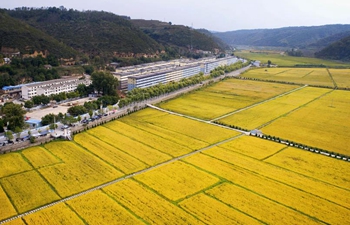CHICAGO, Sept. 14 (Xinhua) -- Researchers at the University of Illinois (UI) have removed one hurdle toward environmental cleanup of certain contaminants with a newly designed synthetic enzyme that reduces the compound sulfite to sulfide.
In the study, the researchers used an enzyme as a scaffold to anchor clusters of iron and sulfur atoms that behave like tiny molecular batteries, transferring the electrons needed to push the redox reaction.
"We focused on the functionality of our synthetic enzyme, not rebuilding the simplest possible structure," said UI chemistry graduate student Evan Mirts. "We accounted for interactions that are typically thought of as secondary, or less important to the overall redox reaction. It turns out that these interactions are extremely important."
"When we accounted for those so-called weaker interactions in our designed enzyme, we suddenly saw redox reaction activity that was very similar to that of the naturally occurring sulfite-reducing enzyme," said Yi Lu, a professor of chemistry at UI.
Sulfite reduction, a common oxidation-reduction or redox reaction, can interfere with the cleanup of a major class of environmental contaminants including nitrate, arsenate and perchlorate. These contaminants enter the environment as byproducts from the production of rocket fuel, munitions and fertilizer. Sulfite also occurs naturally and interferes with the elimination of more toxic compounds.
The researchers are now envisioning their newly developed enzyme inspiring a new generation of catalysts to help clean up toxic waste in the environment and help improve the quality of petroleum products.
The study has been published in the journal Science.

















